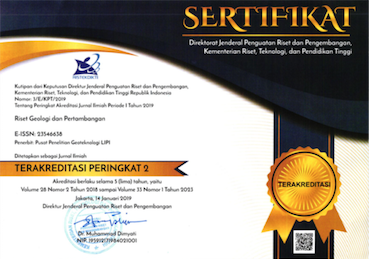Riset Geologi dan Pertambangan - Geology and Mining Research is an open-access journal indexed by SINTA 2. It publishes research papers, reviews, and short communications in geosciences-related interdisciplinary areas. We are pleased to invite researchers and practitioners working in these fields to utilize this journal and to discuss, express and publish their views on the current trends, challenges, and state-of-the-art solutions addressing various issues in the overmentioned areas.
ISSN: 0125 9849
e-ISSN: 2354 6638
Accreditation Sinta 2: 3/E/KPT/2019

Announcements
A Preface from Editor-in-Chief |
|
Dear RGP readers, We present the last issue of Volume 33 of Riset Geologi dan Pertambangan (Geology and Mining Research). This issue publishes five articles that covered topics on resistivity modeling of seawater intrusion, geoelectrical investigation for slip-plane model, geotechnical testing for landslide potential, landslide mapping by frequency ratio, and lead content in reef sediment systems. In the first paper, Utami et al. applied electrical resistivity tomography method to image seawater intrusion along the west flood canal of Semarang in the subsurface. The geoelectrical survey used a dipole-dipole multi-electrode configuration. Their subsurface model shows that the identified seawater intrusion zone is associated with a low resistivity value of less than 3 Ohm.m. This intrusion zone is up to 70 meters deep near the coast and is thinning farther south. Their results confirm that seawater has penetrated long distances to the land below Semarang. Pangaribuan et al. modeled slip plane in Tasikmalaya area using 2D resistivity method with a dipole-dipole array. They measured the resistivity in five lines with 5 m spacing between electrodes and a total length of 275 m. The results show three classes of resistivity values that interpreted as different lithologies. The slip area is within the sandy clay with a slipping mass of clayey/ tuffaceous sand and volcanic breccia. Based on the slope and the slip plane angles, the area has an unstable slope. The third paper (Ahmid et al.) presents research using geotechnical testing and topographical mapping to determine landslide potential in Cihanjuang are, Sumedang, West Java. The geotechnical tests include water content, specific gravity, sieve analysis, hydrometer, and direct shear strength. The geotechnical test results show the soil samples belong to the MH-CH-OH classification. The internal friction angle is relatively steep, and the percentage of gravel and sand is quite high, hence water can easily infiltrate soil Therefore, the study area has a high potential for landslides. From the topographic mapping, the volume of the landslide was around 161.981 m³. Salsabiila et al. present landslide potential investigation in Magelang area, Central Java using frequency method. This method uses parameters of slope, lithology, structure distance, river distance, land use, and landslide occurrence points. Based on their results, the study area is divided into 4 zones: the Very Low Landslide Susceptibility Zone, Low Landslide Susceptibility Zone, Medium Landslide Susceptibility Zone, and High Landslide Susceptibility Zone. After validating the landslide susceptibility map using the Area Under Curve method, the results obtained were 70.95% and included in the good category, so the map was suitable to be used as a reference for landslide potential zonation. The last paper from Nurhidayati et al. examined control of sediment grainsize on lead content in the reef sediment systems of Panjang Island, Banten Bay, Indonesia. They analyzed grainsize, component analysis, and Pb concentration, using AAS flame method. The results indicate that Pb concentration in the grain-supported surface sediment in Panjang Island is varied. The different concentration of Pb value is mainly controlled by the different of sediment grainsize and CaCO3 content. The highest Pb accumulation occurs in the areas with very fine sediment grainsize, which have better adsorption capabilities for heavy metals. They also suggest that the medium sand fraction may accumulate different Pb values. The results indicate that all sediment samples in the study area is in the low risk of toxicant level. Riset Geologi dan Pertambangan (Geology and Mining Research) welcomes your contributions in the forthcoming issues. We sincerely acknowledge the outstanding reviewers who reviewed the submitted manuscripts and all the authors for their valuable contributions to this issue. We recognize all the editorial members and staffs for their continuous excellence support for the publication of our journal. |
|
| Posted: 2023-12-29 | |
| More Announcements... |
Vol 33, No 2 (2023): Riset Geologi dan Pertambangan
Table of Contents
|
Cover dan Preface Volume 33 Nomor 2 Tahun 2023
|
i-vii
|
Articles
|
Amanda Rizky Utami, Lina Handayani, Yayat Sudrajat, Muhammad Hanif
|
69-76
|
|
Risky Martin Antosia, Fitri Pangaribuan, Dadan Dani Wardhana
|
77-88
|
|
Deden Agus Ahmid, Tatang Wahyudi, Kusnawan Kusnawan, Stefanus Suryo Cahyono, Gunawan Gunawan, Zulfahmi Zulfahmi, Budhy Agung Supriyanto, Tarsono Tarsono, Liston Setiawan
|
89-97
|
|
Rana Salsabiila, Eko Teguh Paripurno, Carolus Prasetyadi
|
99-121
|
|
Ayu Utami Nurhidayati, Dwi Amanda Utami, Marfasran Hendrizan, Tubagus Solihuddin, Rima Rachmayani
|
123-134
|







.png)



